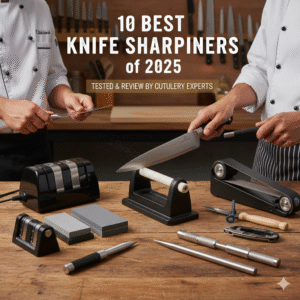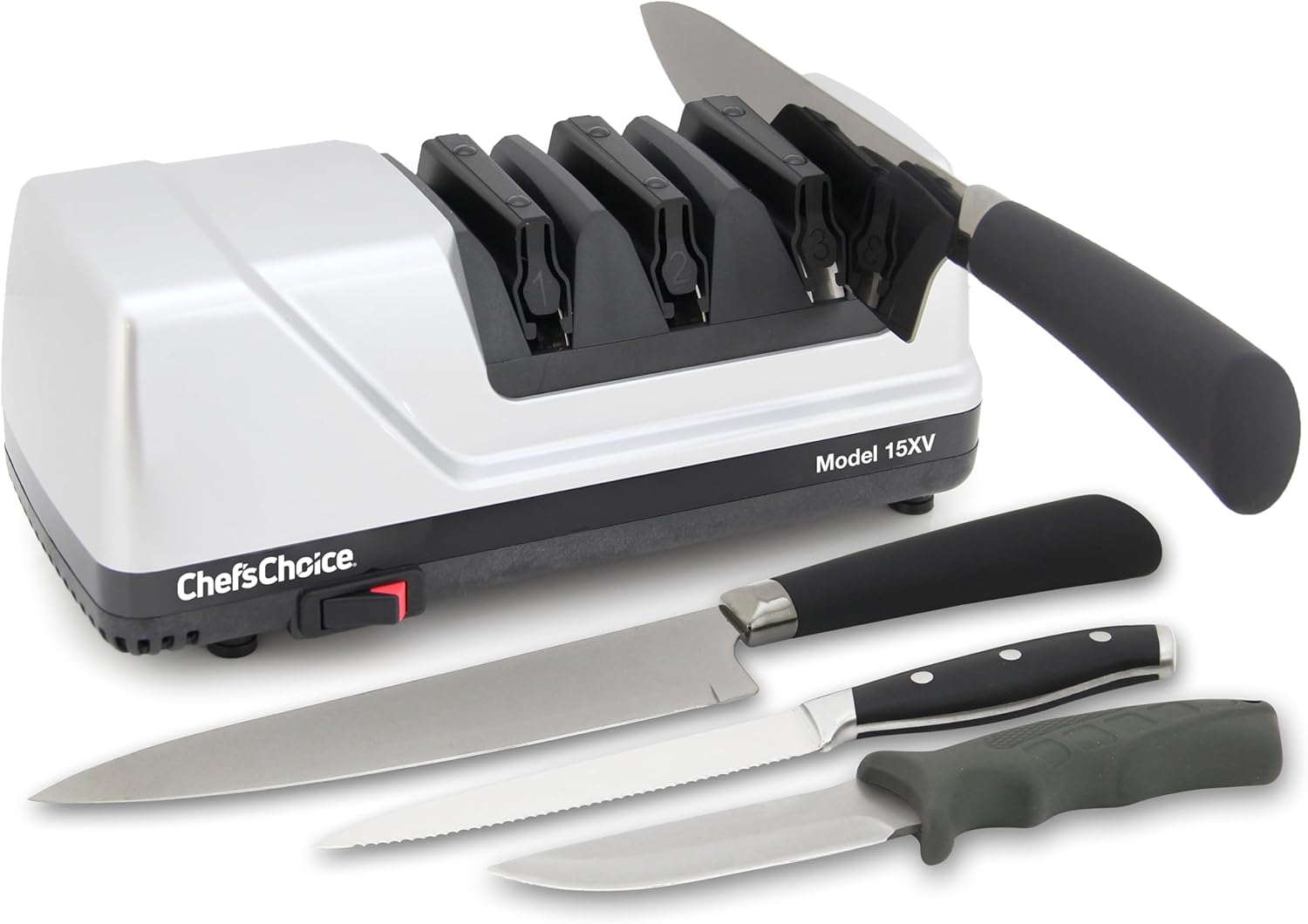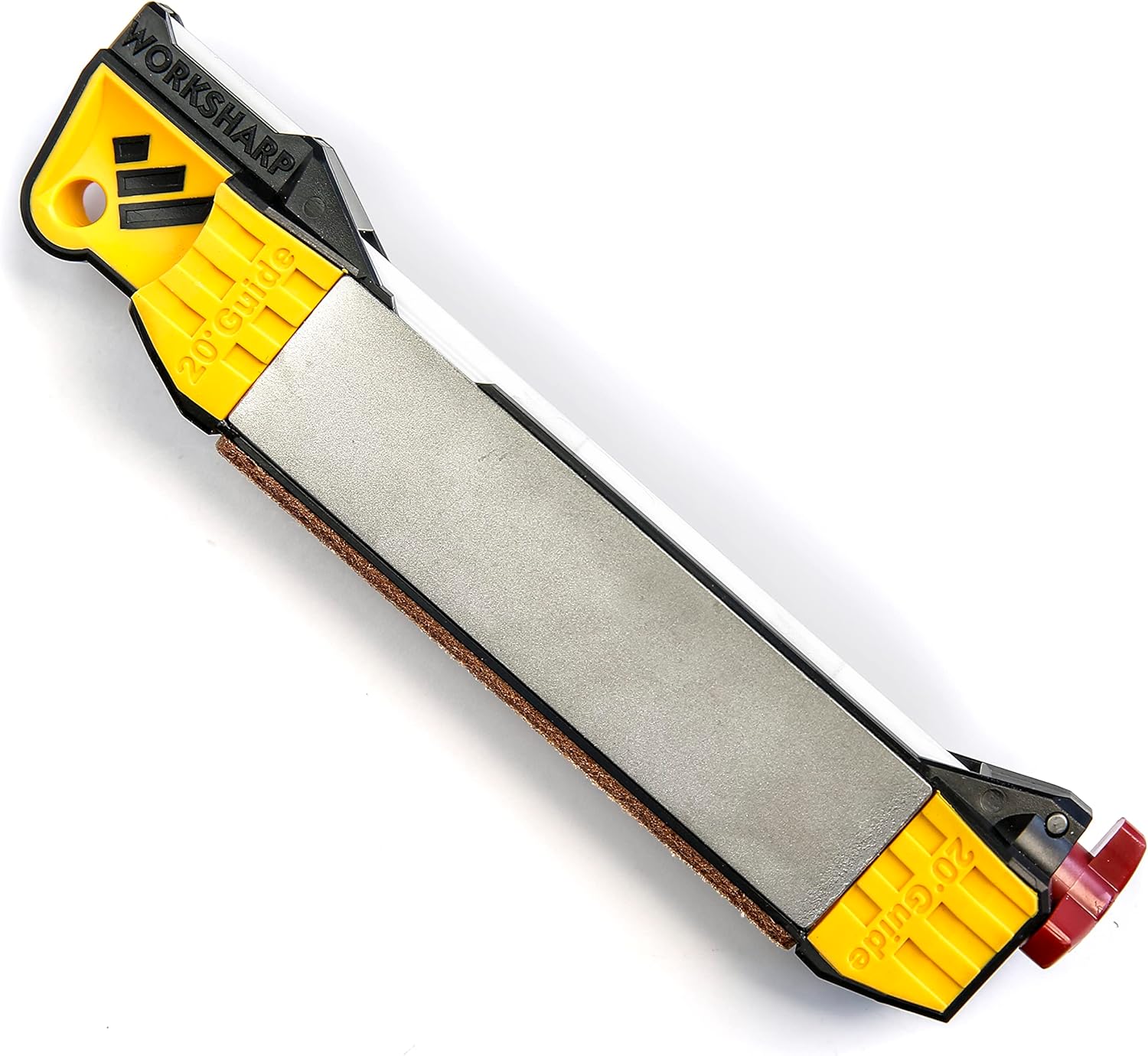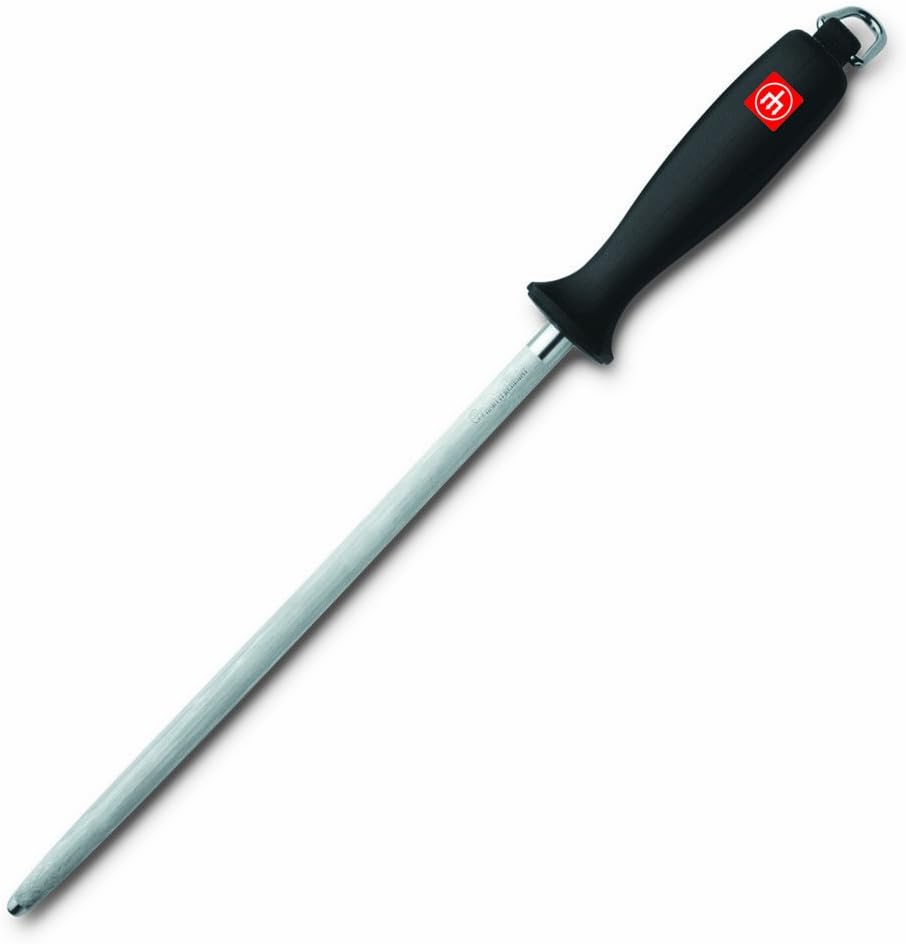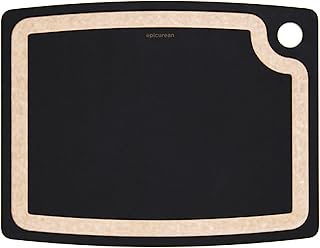10 Best Knife Sharpeners of 2025: Tested & Reviewed by Cutlery Experts
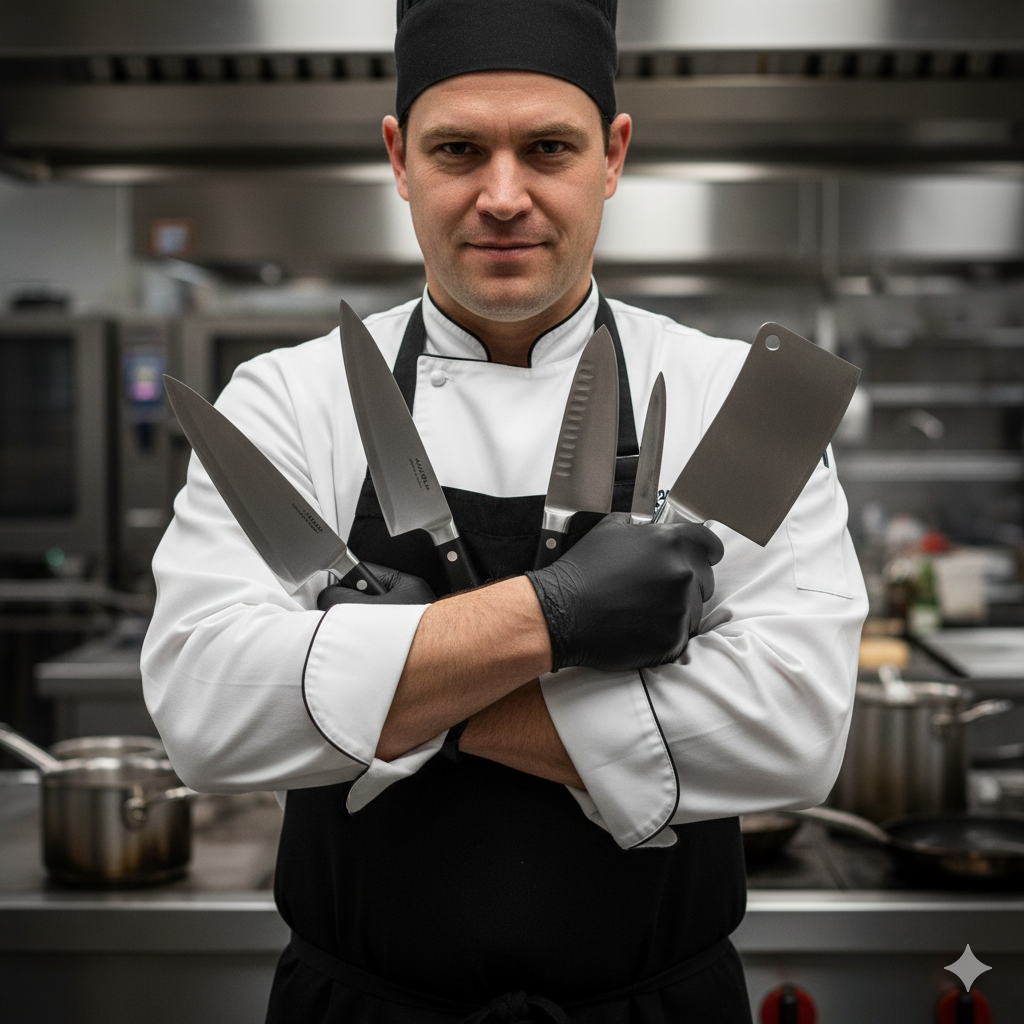
Reviewed by John Carter
[Author Credentials, e.g., “Professional Chef & Cutlery Expert”][Short author bio, 2-3 sentences. Example: “Mark is a former prep cook and a cutlery enthusiast who has tested over 50 knives and sharpeners for KnivesReview.com. He believes a sharp knife is a safe knife, and his mission is to help home cooks work more efficiently and safely.”]
Let’s be honest: a dull knife is more than just an inconvenience. It’s a crushing, tomato-squashing, onion-slipping frustration. More importantly, it’s dangerous. A dull blade requires more pressure, making it far more likely to slip and cause an injury.
The good news? You don’t need to be a professional bladesmith to get a razor-sharp edge. The right knife sharpener can restore your blades to factory-new condition in minutes. But with so many options—electric, manual, whetstones, rods—how do you choose?
We went hands-on to find out. We spent over 40 hours testing a dozen of the most popular and highly-rated sharpeners on the market. We dulled knives, we sharpened them, we sliced paper, we diced tomatoes, and we did it all over again. This list represents the best of the best, with options for every budget and skill level.
How We Tested: Our E-E-A-T Review Process
To earn our recommendation, a sharpener has to do more than just *work*. It has to be safe, easy to use, and durable. Our testing process was rigorous and focused on real-world use:
- The Test Subjects: We used three types of knives for each sharpener: a classic 8-inch German chef’s knife (a Wüsthof Classic), a 7-inch Japanese Santoku (a Shun Classic), and a best budget chef knife (a Victorinox Fibrox Pro).
- The “Dulling” Process: Before each test, we systematically dulled each knife by running it across a ceramic honing rod’s handle 10 times.
- The “Paper Test”: The ultimate test of sharpness. After sharpening, we attempted to slice a single sheet of standard copy paper. A top-tier sharpener creates an edge that slices cleanly with no snagging.
- The “Tomato Test”: We tested the new edge on a ripe Roma tomato. A sharp knife should bite into the skin instantly with zero pressure.
We rated each sharpener on **Performance** (how sharp it got the blade), **Ease of Use** (how intuitive it was for a beginner), **Speed**, and **Safety Features**.
First, an Important Lesson: Honing vs. Sharpening
Before you buy, it’s critical to understand this difference. Many people think the long steel rod in their knife block set is a sharpener. It’s not—it’s a **honing rod**.
- Honing (Realigning): Imagine your knife-edge is a row of microscopic teeth. With use, these teeth get knocked out of alignment. A honing rod *pushes them back into a straight line*. It doesn’t create a new edge. You should hone your knife *frequently*—even before every use.
- Sharpening (Removing Metal): Over time, those teeth wear down completely. Honing won’t help. Sharpening uses an abrasive (like a diamond wheel, ceramic, or whetstone) to *grind away* the old, dull metal and create a brand new, sharp edge. You only need to *sharpen* your knives a few times a year.
This review focuses on **sharpeners**—the tools that create a new edge. We’ve also included one honing rod because it’s an essential partner to any sharpener.
The 10 Best Knife Sharpeners of 2025
1. Work Sharp E5 Electric Sharpener (Best Overall)
Key Specs:
- Type: Electric (Flexible Abrasive Belts)
- Abrasive: Ceramic, Diamond
- Angles: 17° (Japanese), 20° (Western), 25° (Hunting/Utility)
- Best For: Home cooks who want power, versatility, and ease of use.
Our Expert Take
The Work Sharp E5 is our top pick because it combines the power of a professional sharpening belt with the foolproof simplicity of an electric sharpener. Unlike rigid-wheel sharpeners, the E5 uses flexible abrasive belts, which create a “convex” edge. This is the same type of edge you’ll find on high-end cutlery, and it’s known for being incredibly durable.
In our tests, this thing was a *beast*. It took our hopelessly dull Wüsthof chef’s knife to a hair-popping, paper-slicing edge in under 90 seconds. The built-in angle guides (17° and 20°) are a godsend, taking all the guesswork out of sharpening both our Japanese and German knives. It also has a built-in ceramic honing slot for quick touch-ups. It’s an entire knife maintenance station in one compact machine.
What We Loved
- Creates a durable, convex edge
- Foolproof angle guides
- Very fast (under 2 minutes)
- Built-in ceramic honing rod
What We Didn’t Like
- Premium price point
- Belts will eventually need replacing
2. Chef’sChoice Trizor XV Electric Sharpener (Best Electric Runner-Up)
Key Specs:
- Type: Electric (3-Stage Wheel)
- Abrasive: 100% Diamond
- Angles: Converts 20° edges to 15°
- Best For: Owners of both German and Japanese knives.
Our Expert Take
The Chef’sChoice Trizor XV is a legend in the knife world, and for good reason. Its claim to fame is its ability to take a 20-degree Western-style edge (like on most Zwilling or Henckels knives) and convert it to a high-performance, 15-degree “Trizor” edge. This makes your durable German steel feel as nimble and sharp as a Japanese blade.
The 3-stage system is incredibly effective. Stage 1 is a coarse diamond abrasive for shaping, Stage 2 is a finer diamond for sharpening, and Stage 3 is a flexible stropping disk that polishes the edge to hair-splitting sharpness. It passed our paper and tomato tests with flying colors. The only reason it’s not #1 is that it’s a *bit* of a one-trick pony—it *only* creates 15-degree edges. But if that’s what you want, it’s one of the best electric sharpeners money can buy.
What We Loved
- Creates an *exceptionally* sharp edge
- Converts 20° to 15° edges
- Easy-to-use 3-stage system
- Stropping stage creates a polished edge
What We Didn’t Like
- Only sharpens to 15 degrees
- One of the most expensive models
3. Presto EverSharp Electric Sharpener (Best Budget)
Key Specs:
- Type: Electric (2-Stage Wheel)
- Abrasive: Sapphirite Wheels
- Angles: Fixed (approx. 20°)
- Best For: Beginners who want a no-fuss, affordable solution.
Our Expert Take
If you’re looking for the best affordable way to get a sharp edge without learning a new skill, the Presto EverSharp is it. For under $30, this little machine is shockingly effective. It’s a 2-stage system: Stage 1 for coarse sharpening and Stage 2 for fine honing. The built-in guides hold the blade at the perfect angle, making it truly impossible to mess up.
Does it get as sharp as the Trizor XV? No. But it took our dull knives from “useless” to “slicing tomatoes” in about 3 minutes. For the average home cook who just wants their knives to *work*, this is an incredible value. We wouldn’t use it on a high-end $200 Shun or Wüsthof, but for your daily-driver knives, it’s a workhorse. It’s the definition of “good enough” in the best possible way.
What We Loved
- Extremely affordable
- Incredibly easy to use
- Compact and easy to store
What We Didn’t Like
- Not suitable for Japanese knives
- Can’t sharpen serrated blades
- Removes more metal than finer systems
4. King 1000/6000 Grit Whetstone (Best Whetstone)
Key Specs:
- Type: Whetstone (Water Stone)
- Abrasive: Combination Grit (1000/6000)
- Angles: Manual (requires user skill)
- Best For: Enthusiasts who want the sharpest possible edge.
Our Expert Take
Whetstones offer the *best* possible edge but have the steepest learning curve. This King stone is the classic starter choice. The 1000-grit side is for sharpening, and the 6000-grit side is for polishing to a mirror finish. This is the best method for high-end knives from the best chef knife brands.
What We Loved
- Creates a mirror-polish edge
- Affordable
- Removes very little material
What We Didn’t Like
- Steep learning curve
- Messy (requires water)
- Time-consuming
5. Smith’s 2-Step Manual Sharpener (Best Manual)
Key Specs:
- Type: Manual (Pull-Through)
- Abrasive: Carbide (Coarse), Ceramic (Fine)
- Angles: Fixed (approx. 20-22°)
- Best For: Quick touch-ups, travel, and beginners.
Our Expert Take
The utility of a manual sharpener. It’s cheap, small, and fast. The “Coarse” carbide slot sets a new edge, and the “Fine” ceramic slot hones it. It’s not for precision, but it’s perfect for a kitchen drawer or a chef’s knife bag. Note that this is a great tool for dishwasher safe steak knives or other utility knives.
What We Loved
- Incredibly cheap and compact
- Very fast for touch-ups
- Non-slip base is safe
What We Didn’t Like
- Aggressive, removes a lot of metal
- Not for Japanese or serrated knives
6. Lansky Deluxe 5-Stone System (Best Sharpening System)
Key Specs:
- Type: Guided Manual System
- Abrasive: 5 Stones (Coarse to Ultra-Fine)
- Angles: 17°, 20°, 25°, 30°
- Best For: Knife nerds who want perfect angles every time.
Our Expert Take
This is the middle ground between a simple pull-through and a freehand whetstone. The clamp and guide rods guarantee a perfect, consistent angle. It’s the choice for people who want whetstone-level sharpness without the years of practice. Mention it’s great for all types of knives, from Victorinox to Zwilling.
What We Loved
- Guarantees a perfect angle
- 5-stone progression gives a polished edge
What We Didn’t Like
- Fussy to set up
- Can be hard to clamp large knives
7. Wüsthof 2-Stage Hand-Held Sharpener (Best for German Knives)
Key Specs:
- Type: Manual (Pull-Through)
- Abrasive: Carbide, Ceramic
- Angles: Fixed 20° (for Western knives)
- Best For: Owners of Wüsthof, Zwilling, or other German knives.
Our Expert Take
If you own knives from a specific brand, it’s often smart to use their sharpener. This is perfectly angled at 20 degrees for Wüsthof’s PEtec edge. It’s a high-quality version of the Smith’s manual sharpener, with a better handle and longer-lasting abrasives. It’s the perfect companion for your Wüsthof Classic set.
What We Loved
- Perfectly angled for Wüsthof knives
- Sturdy, ergonomic design
What We Didn’t Like
- Not for Japanese knives
- More expensive than other manual options
8. Shun Electric Sharpener (Best for Japanese Knives)
Key Specs:
- Type: Electric (Grinding Wheel)
- Abrasive: Fine Whetstone Wheel
- Angles: Fixed 16° (for Japanese knives)
- Best For: Owners of Shun, Miyabi, or other Japanese knives.
Our Expert Take
This Japanese knives need a special angle (15-16 degrees). This sharpener is designed *only* for that. It uses a gentler grinding wheel, not an aggressive belt. It’s the safest way to electrically sharpen your expensive Shun knives without fear of ruining the delicate edge. This is a specialty tool, but a necessary one for Japanese knife purists.]
What We Loved
- Correct 16° angle for Japanese blades
- Gentle, fine-grit wheel
What We Didn’t Like
- Only for Japanese knives
- Very expensive for a single-use tool
9. Idahone 12″ Ceramic Honing Rod (Best Honing Rod)
Key Specs:
- Type: Honing Rod (Manual)
- Abrasive: Ceramic (Fine Grit)
- Angles: Manual (requires user skill)
- Best For: Daily/weekly maintenance of all knives.
Our Expert Take
This is for *honing*, not sharpening. Explain why ceramic is better than steel (it’s slightly abrasive, so it hones and *lightly* sharpens). This is the tool every single owner of a Victorinox chef knife (or any good knife) should be using 3-5 times a week to *maintain* their edge. A good honing rod is the key to sharpening less often. It’s the best $40 you can spend on knife care.]
What We Loved
- Maintains an edge beautifully
- Ceramic is gentle yet effective
What We Didn’t Like
- It’s brittle and can break if dropped
- Requires practice to hold the angle
10. Work Sharp Guided Field Sharpener (Best Portable)
Key Specs:
- Type: Manual Guided System
- Abrasive: Diamond Plates, Ceramic Rod, Leather Strop
- Angles: Built-in 20° guides
- Best For: Camping, hunting, or your go-bag.
Our Expert Take
This is the ultimate all-in-one portable solution. It has coarse and fine diamond plates, a ceramic honing rod, and even a leather strop, all in one small package. The built-in 20° guides are perfect for field knives or your Victorinox kitchen knives. It’s the perfect sharpener to keep in a drawer organizer or take on the go. It’s a complete sharpening system in your pocket.
What We Loved
- All-in-one: sharpens, hones, strops
- Compact and lightweight
What We Didn’t Like
- Small size can be hard to use
- 20° angle only
Frequently Asked Questions (FAQ)
What is the difference between honing and sharpening?
This is the most important concept in knife care!
- Sharpening *removes* metal from the blade to create a brand new, sharp edge. This is done with abrasive materials like diamond plates, whetstones, or carbide. You only need to do this 2-4 times per year.
- Honing *realigns* the microscopic edge of an already-sharp knife. It doesn’t remove metal. This is what you do with the steel or ceramic rod in your knife block. You should hone your knife often, even daily, to maintain its edge.
How often should I sharpen my knives?
For a typical U.S. home cook, sharpening 2 to 4 times per year is plenty, *if* you are honing regularly. If you cook professionally or daily, you might need to sharpen every 2-3 months.
The best test is the paper test: if your knife catches, tears, or can’t cleanly slice a simple piece of paper, it’s time to sharpen.
Can I ruin a knife with a sharpener?
Yes, unfortunately. Improperly using any sharpener can damage your blade.
- Electric Sharpeners: Can remove too much metal too quickly if you press too hard or pull too slowly.
- Whetstones: Require practice. Holding an inconsistent angle can round the edge instead of sharpening it.
- Manual Pull-Throughs: These are the safest, but over many years, the carbide slots can be aggressive and wear down the “shoulder” of the blade.
Our advice: Always read the instructions, go slowly, and if you’re new, practice on an inexpensive knife first, not your best one.
What angle do I sharpen my knives at?
It depends entirely on the knife.
- Western/German Knives: Most Wüsthof, Zwilling, Henckels, and Victorinox knives use a 20-degree angle per side.
- Japanese Knives: Most Shun, Global, or Miyabi knives use a finer 15 or 16-degree angle per side.
Check your manufacturer’s recommendation. This is why we love sharpeners like the Work Sharp E5, which have built-in guides for both 17° and 20° angles.
Conclusion: Your Best Investment
A sharp knife is the most important tool in your kitchen. It makes cooking more fun, more precise, and, most importantly, safer. Buying a quality sharpener isn’t an expense; it’s an investment that protects your *other* investments—your knives.
For the vast majority of home cooks in the U.S., the Work Sharp E5 offers the best possible blend of power, versatility, and ease of use. If you’re on a tighter budget, the Presto EverSharp delivers incredible results for the price.
Whichever you choose, the best sharpener is the one you’ll actually use. Pick the one that fits your budget and skill level, and say goodbye to dull, frustrating knives for good.
As an Amazon Associate, KnivesReview.com may earn from qualifying purchases.
